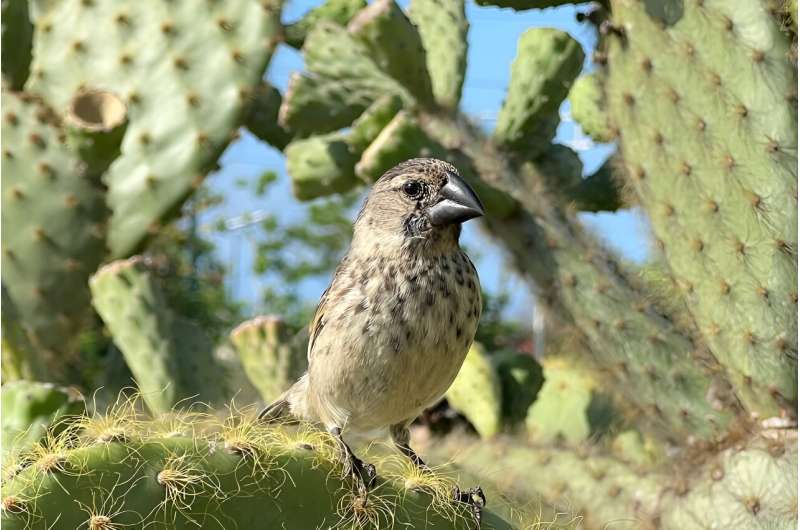This article has been reviewed according to Science X's editorial process and policies. Editors have highlighted the following attributes while ensuring the content's credibility:
fact-checked
peer-reviewed publication
trusted source
proofread
In the Galapagos, urban finches fare better against vampire fly

Scientists are working hard to thwart a blood-sucking fly that is decimating populations of the charismatic finches that helped Charles Darwin formulate the theory of evolution.
In a promising new study led by UConn researchers, they find that populations of finches living in urban environments are somehow more likely to survive the detrimental impacts of the invasive parasite, giving hope for conservation efforts. The findings are published in Global Change Biology.
The avian vampire fly, Philornis downsi, a native to mainland South America, was first found in the Galapagos in the 1950s and recognized as a significant problem in 1997, says co-first author of the study and UConn Ecology and Evolutionary Biology Associate Professor Sarah Knutie.
Although the adult flies feed on decaying organic matter and are non-parasitic, they lay their eggs in the nests of birds where, once hatched, the larvae feed on the blood of nestling birds, often with devastating consequences. The fly is now on almost all islands in the archipelago, and scientists have been working to learn what the long-term effects will be on native bird populations.
"Almost every single study has found a significant effect of the fly on nestling survival and this fly can kill up to 100% of nestling Darwin's finches in a given year," Knutie says. "These nestlings are essentially dying through exsanguination, which means that the larvae are sucking all of the blood, hence the name, avian vampire fly."
With such high mortality rates, the survival of Darwin's finches is in question, and figuring out how to deal with the fly is a top conservation concern for not only the researchers who work with the birds, but the Galapagos National Park, as well.
"The fly doesn't affect all bird species in the Galapagos equally," says Knutie. "Some bird species like the Galapagos mockingbirds are better defended against the flies than Darwin's finches and we think this is because the mockingbirds are compensating for energy loss to the parasite through the parents feeding the nestlings more when they're parasitized, compared to when they're not parasitized."
Knutie began thinking about potential variations in how the flies affect the populations of Darwin's finches and she also noted that previous studies focused on finches living in natural, non-urban settings, which does not give the full picture across all finch populations.
"We know there's different food availability for animals in urban areas, so I started to wonder whether urban finches were differentially affected or maybe better defended against the flies because they had access to different food," she says. "These urban areas are different in so many ways, not just the food availability, but that is where I started because I knew the mockingbirds are better defended because they're able to feed their nestlings more."
The study took place on San Cristobal Island, which is home to one major city, Puerto Baquerizo Moreno, with a population of about 8,000 people. The researchers experimentally manipulated the parasite in nests in urban and nonurban areas where they removed the parasites from some nests. Then they tracked the health and survival of the finches and collected a blood sample to track blood loss and to study gene expression and immune responses.
"We found that when nests were not parasitized, the survival of the nestling birds didn't differ between the urban and nonurban areas so, urbanization itself did not affect the survival. When the nests were parasitized, the survival was over six times greater in urban nestlings compared to nonurban nestlings, whose survival was nearly zero," says Knutie.
To get to the root of the differences in survival between settings, the researchers took a transcriptomic approach.

Cynthia Webster, co-first author and second-year Ph.D. student in collaborator and Associate Professor Jill Wegrzyn's lab, was tasked with understanding the molecular mechanisms behind how parasitism and urbanization influence the outcomes for the finches, including the differential expression of immune genes.
"This transcriptomic approach provides a more holistic view of our system," says Webster. "It's valuable to understand the molecular mechanisms behind what we see and that's where this omics-based analysis adds an extra level to our study."
Webster conducted a gene expression analysis looking at RNA sequence data to see what was actively expressed at the time when samples were taken, specifically comparing urban and nonurban sites, parasitized and non-parasitized individuals, and whether the bird died or survived.
"Based on immune pathways alone, we see that a lot of the differences between parasitized urban and parasitized non-urban fiches lie within resistance and tolerance mechanisms. We zoomed in on the parasitized urban nestlings, where we noticed differentially expressed genes were falling within pathways associated more with tolerance and innate immune resistance. Meanwhile, the nonurban nestlings were showing more adaptive immune resistance," says Webster.
They found that generally, fledging success in urban birds was associated with a pro-inflammatory response, which they think could help prevent the parasites from feeding. The non-urban birds did express immune pathways, but they think it might have been a last-ditch effort to try to defend themselves against the fly, but it was ineffective because most of the birds still died. They also found that urban birds likely consumed more protein, confirming dietary differences between urban and non-urban populations.
The results are encouraging, but Knutie wants to be clear they are not suggesting that the Galapagos Islands should be urbanized; however, the findings lend some hope that there is something about the urban finch population that is improving their outcomes.
"If we can figure out whether it's the evolution of defenses, or if there is an environmental factor that's helping them out, this can help inform conservation or management strategies for other populations, so the bird populations don't decline or go extinct," Knutie says. "This gives us hope that larger populations of Darwin's finches that are affected by the fly are not entirely doomed. We're still worried about smaller populations dealing with the fly, but maybe information from our study can help them.
Knutie says the next step is to figure out whether urban finches have evolved defenses, or if there's an environmental factor, such as food availability, that is helping the finches survive the flies.
"We also would love to expand the study across the islands, because there are four islands in the archipelago with permanent human resident populations and each island has a different size human population. As you can imagine, as the size of the city grows, the infrastructure to support humans grows as well. We hope to test whether the effects of urbanization on this bird/ parasite interaction varies across these islands, based on kind of the degree of urbanization, to see if it's consistent," says Knutie.
Knutie hopes they can elucidate the key mechanisms to help inform future conservation efforts and help with current efforts.
In the native range, the fly's populations are likely kept in check by natural predators like parasitoid wasps or ants, says Knutie. However, those natural control mechanisms are not present on the Galapagos. Some work is underway to study and explore the potential introduction of natural controls, but those measures can be expensive and time-consuming. However, some Darwin's finch populations may not have much time left.
"For instance, the mangrove finch has less than 100 individuals left in the entire species, making it one of the most critically endangered species of bird in the world," says Knutie. "They don't have time to evolve natural defenses, so scientists and the park have been trying to figure out how to manage this fly for these populations that just don't have time. For larger populations, we have a bit more time to figure out why they're not doing so well against the fly, and maybe help them better defend themselves. If it is evolution that's acting on the urban finches, then perhaps that gives us hope that there is a chance for other populations to evolve defenses against the fly."
More information: Sarah A. Knutie et al, Urban living can rescue Darwin's finches from the lethal effects of invasive vampire flies, Global Change Biology (2024). DOI: 10.1111/gcb.17145
Journal information: Global Change Biology
Provided by University of Connecticut




















